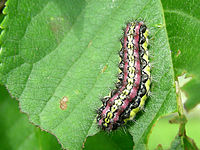| Aglaope infausta | |
|---|---|

| |
| Scientific classification | |
| Domain: | Eukaryota |
| Kingdom: | Animalia |
| Phylum: | Arthropoda |
| Class: | Insecta |
| Order: | Lepidoptera |
| Family: | Zygaenidae |
| Genus: | Aglaope |
| Species: | A. infausta |
| Binomial name | |
| Aglaope infausta (Linnaeus, 1767) | |
| Synonyms | |
| |
Aglaope infausta, or almond-tree leaf skeletonizer moth, is a moth of the family Zygaenidae.
Description

The wings are gray with some red towards the base. The thorax is black and is crossed with a red band. The wingspan is about 15 millimetres (0.6 in). The caterpillar can retract its head into its prothorax. A yellow band with black spots runs along the caterpillar's dorsum. The pupation usually starts in early June as an elongated cocoon that is whitish or light brown. The pupa is pink or yellowish and is 10 mm (0.4 in) long. The larvae feed upon Prunus spinosa, Crataegus sp., Cotoneaster sp., and other species in the family Rosaceae. The species is a pest on foliage and young fruit. The species shows a very low level of genetic heterogeneity for a lepidopteran species, but it does not affect the species' viability. In the Ice Age, differentiation into two genetic lineages occurred.
Mating
The external male sex organs are subject to sexual selection by the female. The male may rub the female's abdomen with its valva during mating. Successful sperm transfer depends upon whether the male spermatophore will fit into the opening of the female ductus seminalis. In a study of sex pheromones, Aglaope infausta was one of the species attracted by tortricids pheromones and caught in the traps.
Habitat
A. infausta is found in Portugal, Spain, France and north-western Italy reaching its north-eastern distribution limit in western Germany. The habitat has to be hot and dry. The species lives in bushy, warm, steppe regions and in forests. The species sometimes shares the habitat of Heterogynis penella.
References
- ^ "Almond tree leaf skeletonizer moth". HYPP Zoolog. Retrieved May 23, 2010.
- ^ Heiko Bellmann; Wijnand Heitmans (2001). "Aglaope infausta". Insekten van Europa (Insects of Europe) (in Dutch). Universiteit van Amsterdam. Archived from the original on 2011-06-08. Retrieved February 18, 2009.
- ^ "Aglaope infausta (Linnaeus, 1767) Aglaope des haies, Zygène des épines, Zygène de l'amandier". Papillons de Poitou-Charentes (in French). Retrieved May 23, 2010.
- ^ Wolfgang Wagner. "Aglaope infausta (Zwerg-Widderchen)". Schmetterlinge und ihre Ökologie (in German). Archived from the original on 5 July 2010. Retrieved May 23, 2010.
- David James Carter (1984). Pest Lepidoptera of Europe: with special reference to the British Isles. Springer. p. 355. ISBN 978-90-6193-504-9.
- Thomas Schmitt; Alfred Seitz (2003). "Low diversity but high differentiation: the population genetics of Aglaope infausta (Zygaenidae: Lepidoptera)". Journal of Biogeography. 31 (1): 137–144. doi:10.1046/j.0305-0270.2003.01003.x. S2CID 82677752. Archived from the original on January 5, 2013. Retrieved May 23, 2010.
- Kauri Mikkola (2008). "The lock-and-key mechanisms of the internal genitalia of the Noctuidae (Lepidoptera)". European Journal of Entomology.
- C. Decamps; P. du Merle; C. Gourio; G. Luquet (1981). "L'attraction d'espèces du genre Zygaena F. par les substances pheromonal produites par tortricids (les Lépidoptères, Zygaenidae et Tortricidae)" [Attraction of species of the genus Zygaena F. by pheromonal substances produced by tortricids (Lepidoptera, Zygaenidae and Tortricidae)]. Annales de la Société Entomologique de France. 17 (4): 441–447.
External links
| Taxon identifiers | |
|---|---|
| Aglaope infausta |
|